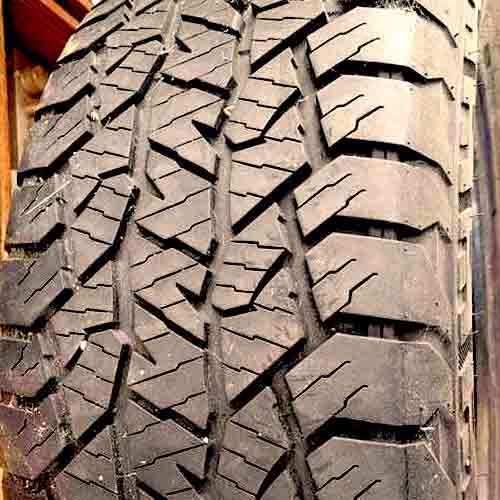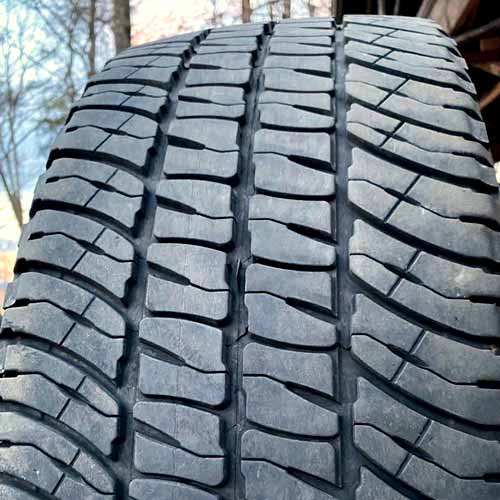All-terrain tires have come a long way in recent years, and both the Michelin LTX AT2 and the Hankook Dynapro AT2 are at the forefront of the progression, especially when it comes to on-road oriented designs. They offer a great balance between performance and comfort, but which one is the better pick for you? Let’s compare and see.

Being a tire engineer, from my perspective, the Hankook Dynapro AT2 comes out on top when it comes to winter traction, providing a quieter/comfortable ride, fuel economy and dry traction. Whereas the Michelin LTX AT2 does better on wet roads, and provides better off-road traction especially on rocky and muddy terrains.
Tire Specs
Starting with Hankook Dynapro AT2, this tire has following specs.
- Sizes: 15 to 22 inches
- Speed rating: S and T
- Load Rating: SL, XL, C to F
- Weight: 29 to 80 lbs
- Tread depth: 12 to 16.4/32″
- Warranty: 60k miles for all
On the other side, the Michelin LTX AT2 comes with following.
- Sizes: 15 to 20 inches
- Speed ratings: R, S and T
- Load ratings: SL, XL, C, D and E
- Tread depth: 14 to 17/32″
- Weight range: 32 to 60 lbs
- Not rated with 3PMSF
- Warranty: 60k miles on all sizes
Tread Pattern
The Hankook Dynapro AT2’s tread can be easily explained by dividing it into 2 parts, central and shoulders.

In the middle:
- Tread makes 3 ribs, and with them 5 tough passing longitudinal channels.
- The central most rib is wider and has notches facing sideways.
- They also carry stepped edges, which enhances off-road bite.
- The surrounding ribs have smaller lugs, and missing such biters, though they carry similar full depth sipes.
- With sipes going all the way deep, they open/flex to provide off-road bite.
On shoulders:
- Shoulder lugs are elongated.
- Here siping pattern is slightly less aggressive, though they are still full depth.
- Towards edges, they don’t make staggered design, and their sidewall lugs are also pretty small.
- In the lateral grooves they make, there are connectors providing lateral stability on pavements.
In comparison the Michelin LTX AT2 features a less aggressive design.

In the middle:
- 2 compacted up ribs are seen.
- These ribs are continuous running from underneath, forming reinforced foundations.
- The lugs pasted on have notches joined up with siping slits, and off-set edges.
- These biters provide off-road traction, while the secondary layers underneath keep the lugs stable on highways.
On shoulders:
- Shoulder lugs are bigger and elongated.
- They have S shaped sipes on them, combined with notches.
- All these lugs also have reinforced foundations.
- Each of these blocks, is serrated on itself, and extend down towards sidewalls to form thick enough lugs over there.
Durability
The durability of off-road tires is a critical factor in their ability to tackle rough terrains which have a lot of different sharp objects, such as rocks, pointy logs, debris, and so on.
This is why cut-resistant rubber, and deep tread voids are standard in nearly all of them, though still, the main durability comes from the internal construction.
Out of both tires, although the Hankook Dynapro AT2 is not that aggressive externally, it take things to the next level by providing 3 ply polyester casing inside.
So you get 3 ply sidewalls on this tire, compared to Michelin LTX AT2 having just 2.
Highway Capabilities
An all-terrain tire’s dry performance is closely linked to its traction both laterally, and longitudinally, so let’s examine each of these elements in more details.
Directional Grip
Even wondered why directional grip gets measured with braking distances? Well, this is because its the traction of the tire when rolling straight, and it depends on the central part of the tread where most of the weight concentration is on.
That’s why out of both tires, the Hankook Dynapro AT2 takes the cake, with it’s continuous running ribs over there, making superior rubber to road contact.
And adding to that, is the tire’s stiffer compound, and solid reinforced foundations. They bring about greater highway stability as well.
Though keep note that the overall difference is very marginal, and its only on the paper that you’d note Michelin LTX AT2 lacking a little bit. (That’s why both of them have similar speed ratings up to T).
Lateral Traction
The outer shoulder lug’s contact with the road is critical in determining a tire’s handling and lateral traction, as highlighted by the transfer of weight during cornering.
And here again both tires show up with similar results.
Though still if you have to pick one here, go with Michelin LTX AT2. This is because the tire is lighter off the two, and so it’s cornering inertia isn’t that much, meaning it does not tend to over and under-steer as much, comparatively.
Hankook Dynapro AT2 on the other side, with 3 ply sidewalls gets to show lagging steering response, in comparison (again by a tiny margin).
Wet Traction
The grip part comes from siping and flexibility in the tire’s tread. These two attributes work in tandem to effectively remove water on a micro level. Let me explain.
Most of the water gets expelled out thorough the grooves, while the rest (small amount) of water particles get stuck between the tread blocks and the road, and cause problems if ample siping isn’t present.
That’s why out of both tires, you see less overall slippage on Michelin LTX AT2. The tire comes with a lot of siping slits connected with the notches, and they together clear off the water much more effectively.
Hankook Dynapro AT2 on the other side, although also features numerous sipes, the tires harder compound don’t let them to effectively contract/expand, and suck water particles in (this is now they work). So you get a limited traction values on this tire.
Though both tires show up with similar hydroplaning resistance, and there’s no issue in that area.
Side Note: If you are looking for wet grip (in A/T tires), I should recommend Falken Wildpeak AT3w (review).
Fuel Usage
The tread composition and the weight of tire both play a critical role in determining the rolling resistance, which then affects fuel usage.
And although both tires come up with similar structural weight (across all sizes), you still get to see better fuel economy on Hankook AT2. This is because the tire has a stiffer compound, and it’s lugs don’t waste energy in to bending as the tire turns, or brakes suddenly.
The Michelin LTX AT2 on the other side, is more susceptible to that, and its softer compound and greater tread depth isn’t helping either. So it’s lugs waste the energy in to flexing, rather than putting it to roll the tire.
Winter Traction
The tire’s suitability for winter driving is determined through a systematic analysis of its performance on snow and ice terrains. These performance metrics include stability, control, and acceleration effectiveness.
And in all of them, the Hankook Dynapro AT2 gets to provide better response. And it makes sense why the tire is rated with 3 peak mountain snowflake rating (unlike its counterpart).
The tire basically offers a lot more biters, and it’s interlocking sipes trap snow particles in a better way, making superior snow to snow contact (which is what you want for top notch winter performance).
Michelin LTX AT2 on the other side, although has a lot of biting edges as well, they are not that effective, as the tire does not offer thermal adaptive rubber. Meaning, they get stiffen up with freezing temperatures, loosing biting abilities.
Tread Noise
Noise is produced by air, which flows in through the grooves on the shoulders (of the tire’s tread), leading to air particles striking the walls around and creating unwanted noise.
But since, the Hankook AT2 shows up with Whisper Grooves technology (a term used to Cooper tires), it gets to be quieter. Let me explain.
This technology is nothing more than placing ridges or you can say connectors between the shoulder lugs. This prevents/restricts air from flowing in and out of the tread easily.
And less air getting in, means less noise getting generated.
Michelin LTX AT2 on the other side, although allows more air to get in, it still not that louder (as you’d see a difference of just 2 dBs between both tires).
It deals with noise with pitch sequencing. I talked about it in more detail here.
Off Road Performance
Strong self-cleaning abilities and durability are essential qualities of good off-road tires. But why is that?
Well, let’s take a closer look at how both tires performed on all of these following terrains to find out.
Sandy Dunes
When it comes to performing well on sand, you need to make sure tire stays afloat. And although this is achieved (to some extent) by lowering the air pressure, some tread features such as the tire’s weight, tread compound and structure still play a significant role.
And considering them all, I have given both tires with similar scores.
The Hankook AT2 although features a softer tread compound, with smoother outer edges, the tire still features a lot of weight, with it’s 3 ply sides. And this makes it susceptible to sinking.
On the other side, the Michelin LTX AT2 is equally bad, as the tire comes with sharper shoulders, having saw toothed edges, and they tend to dig in, even though the tire is much lighter in comparison.
Muddy Areas
With narrower grooves, all-terrain tires create a lot of hindrance, for the thick mud to escape out in time. This causes “mud-packing”, which attracts more mud, and the tire loses all gripping abilities.
With on-road oriented structure, forming circumferential channels, both of these tires over here aren’t fit for any kind of muddy terrains.
They don’t allow mud to easily leave out, especially laterally. So you can say, both of them are rated equal here. Or should I say, both of them are equally bad.
Rocks
When traversing rocky terrains, it’s essential for biters to face on multiple angles. This allows a tire to grip both, laterally and longitudinally.
Both tires although offers decent biters all over the tread, I am going to go with Dynapro AT2 on this one, still.
This is because apart form all the biters, in the form of off-set edges, sipes, and in-groove notches, you also get 3 ply sidewalls on this tire.
And since rocky terrains get to be the most “puncturing”, you get a better confidence inspiring ride here, compared to Michelin LTX AT2.
End Note
Both tires are great all rounder options, if you are looking for daily driving options.
Though still out of them, the Michelin LTX AT2 comes out better off-road, as we just saw above. The tire render superior on-road comfort. And gives you with better tread life (if you compare the LT sizes especially).
Moreover, it’s wet traction is although nothing to be proud off, it’s still better, comparatively.
The Hankook Dynapro AT2 on the other side, is quieter on roads, provides superior fuel economy, winter traction, and gives much better traction on dry roads.